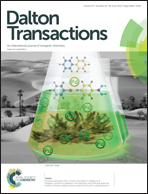The mechanism of the Cu2+[12-MCCu(Alaha)-4] metallacrown formation and lanthanum(iii) encapsulation†
Abstract
A kinetic, calorimetric, mass spectrometry and EPR study has been performed on the formation of the metallacrown Cu2+[12-MCCu(Alaha)-4] from Cu(II) and α-alaninehydroxamic acid (H2L). The acidity range where Cu2+[12-MCCu(Alaha)-4] is stable lies between pH 3.5 and 6.0. For pH values below that range the complex CuHL+ is the prevailing species. This species plays a fundamental role in the formation of Cu2+[12-MCCu(Alaha)-4]. Actually, depending on the Cu(II)/H2L ratio and on pH, it can originate a dimer Cu2(HL)22+ or a dinuclear complex Cu2L2+. Both species constitute the nuclei necessary for a further oligomerisation reaction which ends when the crown is formed. The kinetics of Cu2+[12-MCCu(Alaha)-4] formation is biphasic. Under conditions of Cu(II) excess the fast phase leads to formation of Cu2L2+. The slow phase is interpreted in terms of a sequential addition of monomers (CuHL+) to the Cu2L2+ nucleus to form the crown. The interaction of La(III) with Cu2+[12-MCCu(Alaha)-4] has also been investigated. The system displays a biphasic behaviour; in the first phase the intermediate complex Cu[12-MCCu(Alaha)-4]La is formed which, in excess of ligand, evolves towards the larger metallacrown La3+[15-MCCu(Alaha)-5]. The reaction mechanisms of the two investigated systems are discussed.
![Graphical abstract: The mechanism of the Cu2+[12-MCCu(Alaha)-4] metallacrown formation and lanthanum(iii) encapsulation](/en/Image/Get?imageInfo.ImageType=GA&imageInfo.ImageIdentifier.ManuscriptID=C4DT00557K&imageInfo.ImageIdentifier.Year=2014)

 Please wait while we load your content...
Please wait while we load your content...